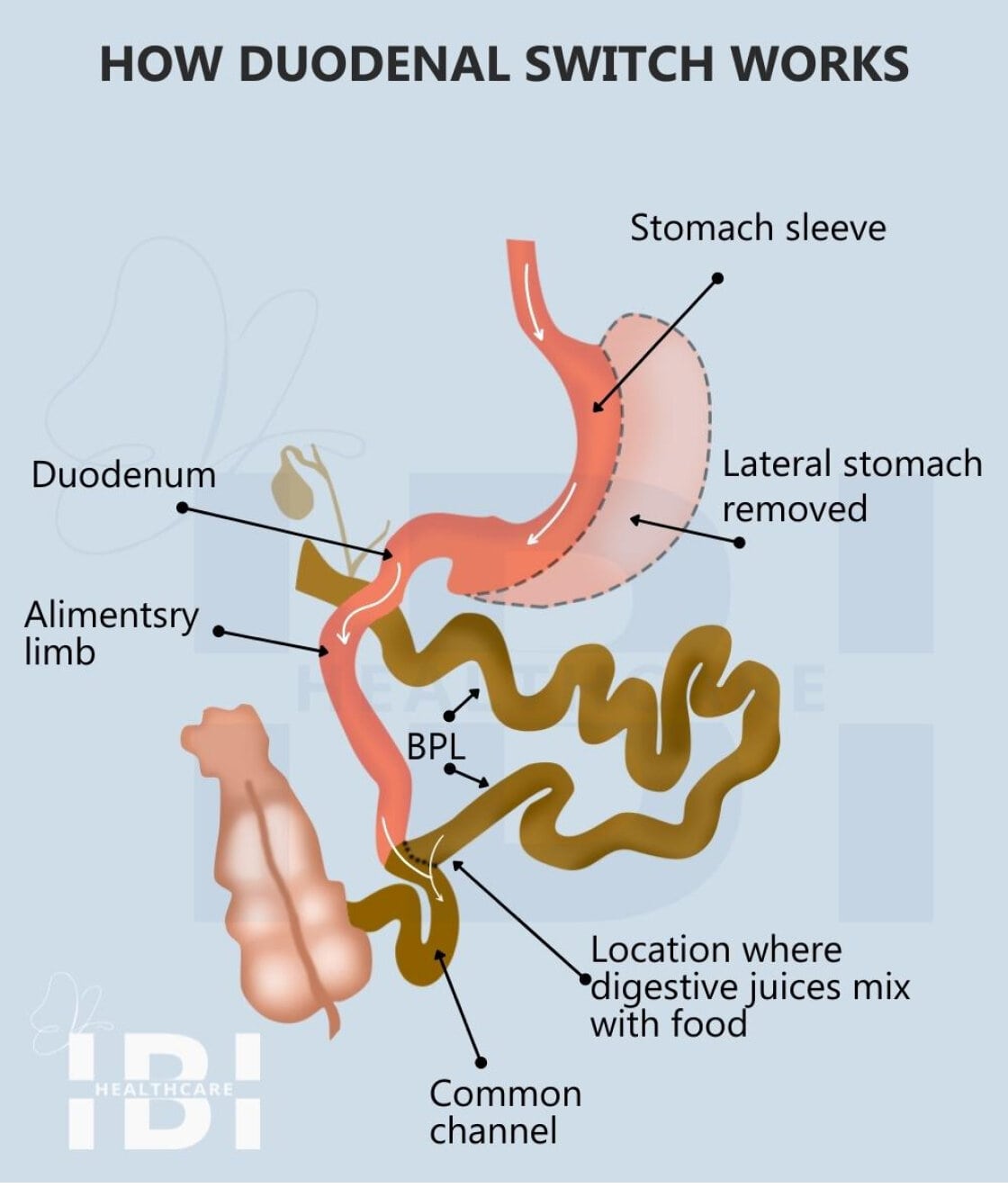What is Laparoscopic Duodenal Switch Surgery?
Commonly referred to as a laparoscopic duodenal switch, surgeons perform biliopancreatic diversion with a duodenal switch (BPD/DS). Though, it is a surgical weight loss procedure. In Addition, it uses both restrictive and malabsorptive techniques to facilitate weight loss. Eventually, surgeons typically perform this procedure laparoscopically. Giving it the well-known name laparoscopic duodenal switch or LDS.
Furthermore, the duodenal switch is a two-part surgery in which surgeons remove a large portion of the stomach (about 75%). On the contrary, surgeons make it smaller using the same technique as gastric sleeve surgery. Then they alter the digestive system by rerouting the small intestine.
Nonetheless, the surgical combination results in significant weight loss for most patients. Because the smaller stomach size naturally limits portion control. Moreover, the alterations to the small intestine prevent the body from absorbing all the calories from the consumed food. Thus preventing the patient from overeating.
Many times, surgeons perform duodenal switch bariatric surgery as two separate surgeries. With a few months in between to reduce risks and prevent long surgical times.
Why consider Laparoscopic Duodenal Switch Surgery?
However, patients who have had gastric sleeve surgery. The incision sites may also swell and feel tender for about a week. Failing to lose the amount of weight they desire. As well as experienced weight regain can benefit from undergoing a Bariatric Revision.
Moreover, converting gastric sleeve weight loss surgery to a duodenal switch. It adds the malabsorptive technique to the restrictive technique stopping weight gain and prompting further weight loss.
Historically, BPD-DS surgery has yielded tremendous weight loss. Many patients have experienced remission or elimination of many serious. Even life-threatening, weight-related medical conditions after duodenal switch weight loss surgery.
Regardless, losing weight through duodenal switch surgery can lower the risks of many serious conditions including:
- Stroke.
- Sleep Apnea.
- Heart Disease.
- Type 2 Diabetes.
- Low Quality of Life.
- High Blood Pressure.
- Depression and Anxiety.
- Several Types of Cancer.
- Abnormal Cholesterol Levels.
- Joint Issues or Osteoarthritis.
- Limited Physical Functioning and Mobility.
How Much Weight Can I Lose with the Procedure?
Nonetheless, patients who have had duodenal switch surgery. Often lose between 65% and 80% of their excess body weight during the first 12 months.
In addition, the formula determines how much excess weight an individual is carrying. Finally, they calculate it by subtracting their ideal weight or goal weight from their current weight.
For Example:
A patient who currently weighs 325 pounds. Whereas, weight is 150 pounds has 175 pounds of excess weight. In reality, if they were to lose 70% of their excess weight (approximately 122 pounds). They would reduce their current weight from 325 to about 202 pounds.
Despite this, patients can lose additional weight or maintain their weight loss. Just by persevering with their healthy low-calorie diet, ongoing exercise plans, and continued behavior modification. Although, most patients will reach their goal weight after 24 months.

Who is the Right Candidate for the Procedure?
BMI (body mass index) of 40 or higher.
A BMI of 35 or higher and suffering from serious weight-related health issues, such as uncontrolled diabetes (Type 2).
Have had previous unsuccessful bariatric procedures.
Meanwhile, patients considering duodenal switch surgery must commit to making permanent changes in their lifestyle, including diet and exercise. In fact, they must also dedicate themselves to lifelong participation in follow-up care and utilizing support systems.
How much does Duodenal Switch Surgery cost?
In reality, the average cost of duodenal switch surgery in the United States is between $21,000 and $29,000. In fact, insurance may cover Duodenal Switch (DS) surgery, offsetting the amount paid by the patient. At the same time, the use of FAS HSA, or other resources may help reduce patient out-of-pocket responsibility.
While comparing costs associated with the duodenal switch procedure. Indeed, keep in mind that most quotes are not all-inclusive. They do not include any necessary fees. For instance, the quote you receive may not include the fee for anesthesia, the operating room, or the surgical facility. Also, it is important to understand who is performing your surgery makes up a portion of the surgical costs. The skill, expertise, and extensive knowledge of the surgeon contribute to the cost.
On the other side, IBI Healthcare Institute’s transparent pricing structure is all-inclusive. And you will understand your financial obligation before the surgery so there are no unpleasant surprises. In any case, learn more about DuoDenal Switch Surgery cost by visiting our Pricing Page. Furthermore, IBI Healthcare Institute offers Financing Options for qualified patients.
When will I start seeing Results from the Procedure?
Typically, patients lose weight rapidly following duodenal switch surgery. Despite this fact, patients see the most dramatic loss of their excess weight in the first three months. Even so, many patients report losses of between 40 and 90 pounds by 90 days post-op.
Even though it may seem, that weight loss speed may vary by patient. The surgeon has two options. Either complete the surgery in one session or split it into two procedures. However, duodenal surgery helps patients lose a tremendous amount of weight for the following reasons:
- The reduction in stomach size forces portion control.
- The re-routing of the small intestines limits the absorption of calories during digestion.
- Duodenal switch surgery greatly reduces the production of the hunger-inducing hormone ghrelin, which is responsible for the hunger messages transmitted from the brain, by eliminating a large portion of the stomach. Moreover, patients experience longer-lasting fullness, and they don't constantly experience hunger pangs.
How long will the Results from Duodenal Switch Surgery last?
Granted, individuals expect the results of duodenal switch surgery to last a lifetime. On the condition that the patient continues to maintain their commitment. Practicing and implementing the necessary lifestyle changes like diet and exercise.
Does Duodenal Switch Surgery have any Associated Risk?
In the final analysis, most duodenal switch side effects are mild and doctors can control or correct them. However, duodenal switch, like any surgical procedure, has associated risks. Still, some possible risks include:
- Infection.
- Excessive Bleeding.
- Breathing or Lung Issues.
- Gastrointestinal System Leaks.
- Deep Vein Thrombosis or Blood Clots.
- Negative Reaction to General Anesthesia.
Some rare, but long-term, side effects of duodenal switch surgery include:
- Ulcers.
- Hernias.
- Gallstones.
- Malnutrition.
- Bowels Obstruction.
- Stomach Perforation.
- Hypoglycemia or Low Blood Sugar.
- Dumping Syndrome – Diarrhea, Nausea, or Vomiting.
Is Laparoscopic Duodenal Switch Surgery Reversible?
Surgeons consider duodenal switch surgery permanent. However, they may reverse a portion of the procedure in certain cases.
Since the surgeon removes a portion of the stomach. During the “gastric sleeve” portion of the surgery, there is no way to reverse this. Yet still, it is possible, in some cases, to reverse the alterations to the small intestine. Particularly for patients who experience digestive issues after duodenal switch surgery.
How do I Know if Duodenal Switch Surgery is Right for Me?
Patients who suffer from severe obesity are normally good candidates for duodenal switch surgery. Equally important, a consultation with a bariatric surgeon is an excellent way to learn more about different weight loss procedures. Furthermore, determine if traditional duodenal switch surgery or the SADI-S technique may be the best option for you.
Traditional Laparoscopic Duodenal Switch Surgery vs. SADI-S
As a matter of fact, traditional duodenal switch surgery alters two portions of the small intestine. However, there is a modified duodenal switch (loop duodenal switch) or SADI-S. It alters only one portion of the small intestine. In fact, surgeons have found that the SADI-S Technique reduces the chances of patient malnutrition. Although, it can be a long-term side effect of duodenal switch surgery.
How Long is the Recovery from Duodenal Switch Surgery?
Duodenal switch recovery will vary for each patient and will depend on many factors, accordingly. In addition to the technique used for the duodenal switch procedure. Therefore, the general health of the patient and any complications that may arise are important factors too.
Overall, this is a more difficult surgery. It takes longer to perform than most other bariatric weight-loss procedures. That makes the duodenal switch recovery time significantly longer as well.
Afterward, many individuals experience pain for about a week to ten days. But they can manage it with pain medication prescribed by the surgeon. The incision sites may also swell and feel tender for about a week.
Additionally, it is important to follow all of the aftercare directions provided by the surgeon. It will mitigate the risks of infection or other complications. No matter how these instructions will also detail any activity restrictions. Patients must adhere to it as they recover to prevent any damage to the surgical sites.






